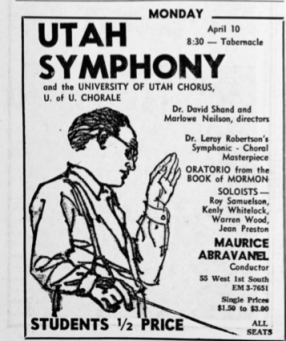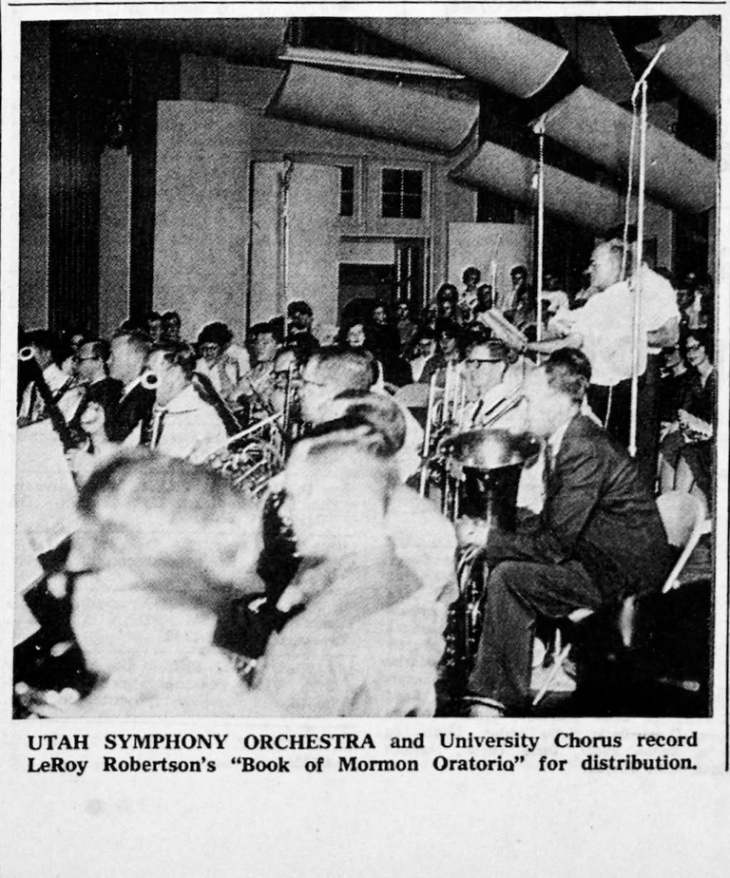The state of Utah is known across the nation for a few things, such as: “the greatest snow on earth,” the beautiful outdoors, and most prominent of all — Mormonism. In the same religious thread, The Book of Mormon musical is well known as well. This begs the question, can Utah possibly be known for the arts?
Leroy Robertson was a Utah native, born and raised in a Mormon household in Fountain Green, Utah. According to Hukill, “His early years were marked by extremely limited opportunities for musical exposure, lack of financial resources, and an overwhelming desire to become a violinist.” (p. 1) Despite this, Robertson learned about music by analyzing scores from great composers. Hukill reports he even “carved his first violin out of wood, and strung it with horse hair from the tail of the family mare.” (p. 1) After hard work, Robertson was able to save enough money to study music at the New England Conservatory in Boston. He went on to perform all over the world and teach music, including here in Utah at Brigham Young University and eventually the University of Utah, where he was the head of the music department.

An ad in the Daily Utah Chronicle for the performance of the oratorio at the Tabernacle.
Robertson wrote an oratorio based on The Book of Mormon, the sacred text of The Church of Jesus Christ of Latter-day Saints. An oratorio is a large musical production that acts as a story based on religious themes by using an orchestra and voices. On April 10, 1961, Robertson performed his oratorio in the Tabernacle, accompanied by the Utah Symphony Orchestra and The University of Utah chorus. Maurice Abravanel conducted the oratorio.
This particular performance was special for a variety of reasons. It would be the first performance of the oratorio in over six years. On April 6, 1961, The Vernal Express reported, “The performance had its world premiere in mid-February of 1953 in Utah’s capital city.” Robertson would be back to showcase his star after a long wait. On the day of the performance, The Daily Utah Chronicle said Robertson “has come to be regarded as one of the most significant composers of the contemporary period.”
The oratorio had gathered its prestige in its six years on and off the charts and was a source of pride for not only Robertson, but the entire state. On April 7, 1961, The Bingham Bulletin characterized the oratorio as “the finest large-scale choral work ever written in this hemisphere.” Even more, residents across the state were proud of this musical work, as The Vernal Express published on April 6, 1961, “Utahns can well be proud of the tremendous talent which goes into such a project as the performance of this great work.”

The Daily Utah Chronicle announced on April 7, 1961, that the oratorio would be recorded.
The oratorio and its recording were anticipated widely across the state, with advertisements in many of the newspapers and publications. This event was accessible to all residents in Utah, and especially for students. The Daily Utah Chronicle advertised in its April 10, 1961, issue about the performance with a drawing of Robertson conducting. It also stated that students received half price on tickets.
Adding another level of significance to this particular performance, The Daily Utah Chronicle reported on April 7, 1961, that the performance was “being recorded by Vanguard Recording Society by the Symphony and the University singers.” The Vanguard sound recording is significant because it created an everlasting memory of this particular performance. The oratorio, of course, was performed many more times throughout history but never like this — with such a strong local emphasis, dedication to the craft, and with the composer himself at the helm. With this performance, the heart of the piece was driven home.
Through his work on the oratorio, Robertson made a name for the arts in Utah. The oratorio changed the fate of classical music while giving Mormonism a new artistic outlook. His legacy shares many things with us, but most importantly, that the arts can be cultivated in any place in the world — no matter the city, no matter your upbringing, and no matter your access. The Oratorio from The Book of Mormon is a testament that art is everlasting.
Palak Jayswal is a senior at the University of Utah. She is majoring in communication with an emphasis in journalism and minoring in creative writing. She is also the arts editor at the Daily Utah Chronicle.
Primary Sources
“LDS Oratorio Set April 10 in S.L. Tabernacle,” The Vernal Express, April 6, 1961, 2.
“Symphony, Chorus to Tape, Perform Robertson Work,” The Daily Utah Chronicle, April 7, 1961, 1.
“Oratorio To Be Given Monday in Salt Lake,” The Bingham Bulletin, April 7, 1961, 1.
“Dr. Robertson’s ‘Oratorio’ Set Tonight,” The Daily Utah Chronicle, April 10, 1961, 1.
Advertisement for the “Oratorio of the Book of Mormon,” The Daily Utah Chronicle, April 10, 1961, 4.
Robertson, Leroy J, Roy Samuelsen, Kenly Whitelock, Jean Preston, Warren Wood, and Maurice Abravanel. Oratorio from the Book of Mormon. New York: Vanguard Records, 1961. Sound recording.
Secondary Sources
Hukill, Cynthia. “A Stylistic Analysis of Selected Piano Works of Leroy Robertson, (1896-1971).” PhD diss: University of Missouri-Kansas City.
